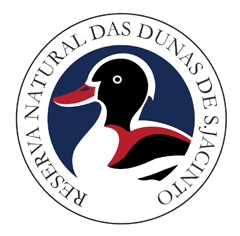Presentation
-
Dunas de S. Jacinto Nature Reserve - RNDSJ (960 ha, of which 210 ha are maritime area) is on the Aveiro Estuary in a thin sandy peninsula separating the salt water from the brackish water to which the Vouga river gives a sweeter taste.
The dune rope, stretching along the Atlantic, is consolidated by spontaneous vegetation, such as Beach grass, Sea Holly, Snowbell, and borders an area forested with Maritime Pine, and Acacias, since the end of the 19th century, with the purpose of fixing the sands. In the ocean front we can observe the sea birds, with highlight to the waders during migrating season. The quagmires or duck ponds that have varied aquatic vegetation were created during the 80's of the 20th century, to serve as refuge for the estuary's anatidae and shelter to a population of herons. An extensive walkway, running between the waters of the estuary and the beach facing the varying moods of the sea, makes us discover the beauty of a small strip of land that was once part of the ocean.
-
Instituto da Conservação da Natureza e das Florestas, I.P. (ICNF, I.P.)
-
Cliffs and beaches
-
Center
-
Aveiro
Identification and Access
-
Access coming from:
- Aveiro heading towards the beaches, following the A25 until Barra beach, then traverse by ferryboat until São Jacinto;
- Estarreja, follow the N109-5 and after you cross the Varela Bridge, turn righ to Torreira by the N327;
- Ovar, using the N327 between Furadouro and Torreira, until São Jacinto.
-
Yes
Tip
-
Visit the different sides of this natural reserve - sand beaches, dune vegetation, pine woods, and all types of dunes that give it it's name. This is a place where visitor easily establish a strong connection with the natural support in which we all exist.
Before entering the Reserve, visit the Interpretation Centre.
Visits without a guide - for your safety, your presence in this Nature Reserve must be authorized. So, ask for information in the reception. When closed, please don´t enter in the Nature Reserve! Contact us: (00351) 960 335 438. Entrance: 9:30 am to 12 am, and 1 pm to 5 pm.
Guided visits, upon booking only. Groups must have a minimum 10 and maximum 30 elements. Up to two visits may be held per day starting at 9:30 am and/or 2 pm. Contact us: 960 335 438
To see the fauna leave early in the morning or a bit before dusk. If available, remember to take binoculars and a camera (don't forget to visit the ponds). Always pay attention to the weather forecast and avoid performing activities in days of rain, thunderstorm or fog. Take precautions and use insect repellent. Use simple and comfortable clothes. The trails are made up of sand so beware. Make outerwear, food, water, sunscreen and/or a raincoat available. You may also want to take a cellphone and flashlight (do not start a fire and don't dispose of cigarette butts incorrectly).
In case of an accident or unforeseen event contact the emergency service 112.
Supports in place
-
The Reserve has directional and informative signs throughout all of its area.
-
No
-
Yes
Activities and field trips for schools only by previous booking.
Statutes of Conservation
-
PTZPE0004 Ria de Aveiro
-
Dunas de S. Jacinto National Woods.
near you
-

Estarreja, situated north of Aveiro, has a nature and biodiversity conservation project designated Bioria, which preserves an important natural heritage associated with the Ria de Aveiro. Start your visit at the environmental Interpretation center, located in Salreu, and go through some of the available trails.
-

The "Barrinha de Esmoriz", also called Paramos lagoon, is a coastal lagoon with an interesting variety of vegetation, including important extensions of reeds, pine forests, riparian forests along its banks, mud banks and an important set of dunes that separates it from the sea. This wetland has a major importance for water birds.
-

The Ílhavo Maritime Museum, housed in a beautiful example of modern architecture, witness the strong link between local population and the sea and Ria de Aveiro. The cod fishing, in the waters of Newfoundland and Greenland, and the relation between agriculture and the estuary are the most important references. There is a remarkable collection of ship models and interesting aquarium codfish.
similar
-
A ria de Aveiro is distinguished by its extension of marshes, salt marshes, reeds and associated agricultural areas, which, taken together, are very important for birds, reason to be integrated in the Natura 2000 network - Aveiro Special Protection Zone.
Weather Conditions
What you can do
1. With the flourishing vegetation is a great time to identify the plants along the pathways.
2. For bird lovers, wake up early and listen to the mating calls.
1. The trail crosses areas with strong contrasts, with sun and shade, a detail to enjoy. Taste mature camarinhas (the fruits of Corema album), one of the nature flavors.
2. Sea and forest are so close... Sun, diving and hiking and then, in local restaurants, enjoy the tasty fresh fish of the sea and the estuary.
1. Know the mushrooms in the Nature Reserve and the arrival of waterfowl to pateiras (lagoons).
2. An afternoon walk is good to spot one beautiful sunset on blue sky days.
1. Silently, visit the Nature Reserve pateiras (lagoons). In the morning or in the evening, see the waterfowl daily lives. Take good pictures!
2. Observe seabirds. Flocks of thousands and thousands of waders cross the air.
3. It is the best time to observe mosses, lichens and mushrooms.
Best Season: All year long
Reserva Natural das Dunas de São Jacinto (Headquarters)
Estrada Nacional, 327
800-901 S. JACINTO
Telephone: (00351) 234 331 282
E-mail: rndsj@icnf.pt







